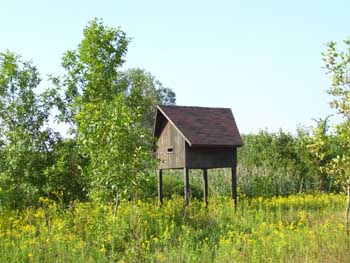Buttonbush Trail
Liberty Park-Pond Brook Conservation AreaMetro Parks, Serving Summit County
Trail Location
Twinsburg Township, Summit County
The Pond Brook Conservation Area of Liberty Park is located just East of Twinsburg on State Route 82, at the Summit-Portage County Line. From Interstate 480, take the Route 82 exit at Twinsburg. Head east on 82, past Route 91. The parking lot will be on the left (north) side of the road just before you reach Aurora.

The "Bat Condo" at Liberty Park.
Trail Summary
Length: 1.8 Miles
Duration: 1 hour
Surface: natural, some gravel sections, some boardwalks to avoid muddy areas.
Type: Loop Trail-Hiking,
Difficulty: easy, virtually flat
Accessibility: The trail is not ADA accessible.
Trail Description
Liberty Park is a cooperative effort of Metro Parks, Serving Summit County, and the City of Twinsburg. The City and Metro Parks own and manage the 1,435-acre park jointly for multiple values. Twinsburg manages a portion of the site for active recreation, such as ballfields, and a dog park. Metro Parks manages the vast majority of the park as the Pond Brook Conservation Area, for the conservation of natural resources and limited passive recreation. The Buttonbush Trail traverses a small portion of the conservation area.
The Buttonbush Trail is a 1.8 mile walking trail which will take you along old access roads that once served oil and gas wells on this large property, and then into a forested wetland complex. Walking clockwise on the loop trail, you will pass by some old field environments first. In September, the trail was first lined with small fields of vibrant yellow Canadian Goldenrod, rich purple Ironweed, stunning New England asters, and a number of white asters. In northeast Ohio, this is a community of disturbance, a forest waiting to happen. As you walk a little further up the trail, you will enter a young woodland area. here the trail is lined, sometimes on one side, somethimes both, with a hedge of Glossy Buckthorn. This non-native European invader is present in great quantities along the sunnier sections of trail here. In the more shaded areas, the shrub is still present in patches here and there, but not as intrusively prominent as along this first stretch of trail.
Although this section of trail goes through an area that was once rather disturbed, many species call this area home. Mixed in with this invasive shrub you will find some native arrowwood viburnum (Viburnum recognitum), Box Elder (Acer negundo), and a number of other plants, such as the native wildflower, turtlehead (Chelone glabra), a native wildflower that can grow to three feet tall and inhabits streambanks or wet ground. If you have pets or kids along, make sure to keep them away from the trail edges, as poison ivy lines much of the trail as well.
As you hike along this walking trail in rural Twinsburg, the forest starts to close in on you a bit, with older trees providing more shade and the groundcover becomes less dense. You will see the dark fissured bark of Black Willow (Salix nigra), and the ominous looking but harmless lower branches of pin oaks, which die as the tree grows, but do not fall off readily. Red maple is a common site in these wetland forests. Here and there you will see the rough-toothed, asymetrical leaves of the American elm (Umlus americana) as well. In this section of forest, it seems that bird life abounds. Three common flickers darted back and forth between trees as we walked through a more mature area of woods. The flicker is easy to recognize ion the wing, with its perfect circle of white visible on its posterior between wing-beats.
Soon, the trail leaves the old gravel roadbed and heads into a young wet woods dominated by red maple. This young woods, with its sparse groundcover and high pole count, seems nearly dead compared to the earlier strech of trail. However, this flat, broad woods is the very definition of life. Here, dozens of barely perceptible stream channels criss-cross the landscape. Dry most of the time, diring rain, these little rivulets collect the water that falls on this forest and directs the water to larger and larger channels until it flows into Pond Brook, then Tinker's Creek. Tinker's Creek is the largest tributary to the Cuyahoga River.
By Preserving this large park that protects a portion of the Pond Brook watershed, Metro Parks, Serving Summit County and the City of Twinsburg not only provided a public amenity beyond compare. They have played an active and important role in helping to clean up and prevent future pollution of our nation's water resources.
Too soon, it seems, you will leave the woodland and re-emerge in an old field of beautiful goldenrod. Quaking aspen trees with their shimmering leaves quaking in the wind make a rustling sound as you walk past. Just off to the right, up ahead is an unusual site. Here, Metro Parks has installed a "Bat Condo". This structure that looks like a small cottage on stilts, is designed to hold 6,000 female bats and their young. Northern long-eared bats, little brown bats and other species of bats call this park home. The bat condo provides a great roosting place, as well as a point of interest for hikers.
From here it is just a short jaunt back to the parking lot. The remainder of the hike is in open territory, perhaps affording an opportunity to see a bald eagle cruising in the sky overhead.
